 We wouldn’t normally bore you with tales of how many more percent of the UK population have joined the Digital TV-owning army, but this one is a significant one.
We wouldn’t normally bore you with tales of how many more percent of the UK population have joined the Digital TV-owning army, but this one is a significant one.
For the first time, the number of households having the BBC-backed Free-to-Air service, Freeview, has exceeded their analogue cousins. Nearly 7.1m have Freeview and 6.4m are still analogue only.
Freeview will also be pretty pleased that for the third successive quarter their sales have exceeded the 1 million mark, achieving 1.2m between January and March, up 40% over the same period last year.
Digital satellite is still the Digital Daddy, with 7.7m homes subscribing to Sky and the remaining 645,000 receiving free-to-view satellite.
There would have been relief at the recently-merged UK cable companies when they saw that there’d been an increase in the number of subscribers. The gain for NTL is only 5,000 subscribers in real terms as the additional new now-digital 70,000 digital cable subscribers were laid off against the 65,000 analogue subscribers who switched. These figures relate to the pre-merged companies.
Interestingly there still around 500,000 analogue subscribers out of the 3.3m total cable subscriber-base. Changing these has got to be a priority if NTL want to start making the returns they need from subscribers.
 TV over ADSL First
TV over ADSL First
For the first time Ofcom has reported separate figures for TV over ADSL services. Currently this is only London-focused HomeChoice, but they will be joined in short order by other IPTV companies like BT Vision. HomeChoice gained at a rate of 21.4% over the same period in 2005, ending with 48,545 subscribers.
Breaking down Sky’s figures
There’s some interest to be had comparing Sky’s Q4, 2005 figures with Q1 2006 – a couple of surprises lie in there.
Churn (number of subscribers leaving the service) is up to 11.4% over 10.6% and ARPU (Average Revenue Per User) is down £5 to £392 from £397. This doesn’t sound like a lot until you look at it in terms of income loss – over £38m.
On the positive front there was a gain of 87,000 households, with multi-room households gain 84,000 and Sky+ users up 149,000, now hitting 1,430,000.
 Additional TV Sets – Ongoing problems
Additional TV Sets – Ongoing problems
Ofcom are estimating that 38% of Freeview sales are intended to secondary TV sets which will start to allay a lot of fears.
The big hurdle for the UK digital switch-over gang is the replacement of the non-primary TV set, the bedroom TV & video, little Johnny’s TV and the spare that the babysitter uses. When the analogue-broadcast lights go off is when these people start to yell.
 Mobile phone companies have been striving to develop high resolution displays to capitalise on the potential of multi-media content. This week, Samsung joined the growing list of manufacturers who have created a true VGA display suitable for mobile phones.
Mobile phone companies have been striving to develop high resolution displays to capitalise on the potential of multi-media content. This week, Samsung joined the growing list of manufacturers who have created a true VGA display suitable for mobile phones. VGA has been available on handheld devices for a while now. Toshiba debuted the first PDA with VGA display (the e805) back in December 2003 and the first VGA mobile, Sharp’s 904SH, launched in Japan in April this year. The latter has four times the resolution of the average QVGA (Quarter VGA) display and face recognition functions that authenticates users by their facial features.
VGA has been available on handheld devices for a while now. Toshiba debuted the first PDA with VGA display (the e805) back in December 2003 and the first VGA mobile, Sharp’s 904SH, launched in Japan in April this year. The latter has four times the resolution of the average QVGA (Quarter VGA) display and face recognition functions that authenticates users by their facial features. Sad but (supposedly) true: a new study by Nokia has found that over one in five mobile owners said they’d find losing their phone more upsetting than their wallet, credit cards and – unbelievably – even their wedding ring.
Sad but (supposedly) true: a new study by Nokia has found that over one in five mobile owners said they’d find losing their phone more upsetting than their wallet, credit cards and – unbelievably – even their wedding ring.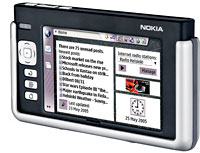 Nokia commissioned the research in 11 countries around the globe to discover people’s attitudes towards current and future mobiles, and generally found that people *heart* the things the planet over.
Nokia commissioned the research in 11 countries around the globe to discover people’s attitudes towards current and future mobiles, and generally found that people *heart* the things the planet over. Surfing on the move
Surfing on the move Dandruff shakers looking forward to some geriatric rocking with Guns’n’Roses at the Hammersmith Apollo tomorrow night can forget all about keeping their tickets as a memento after the show.
Dandruff shakers looking forward to some geriatric rocking with Guns’n’Roses at the Hammersmith Apollo tomorrow night can forget all about keeping their tickets as a memento after the show.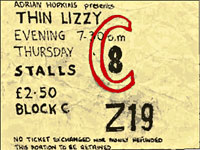 Moreover, we don’t even like the idea of having tickets on our mobiles. What happens if your battery runs out, or if you delete your text message by accident?
Moreover, we don’t even like the idea of having tickets on our mobiles. What happens if your battery runs out, or if you delete your text message by accident? Regardless of what punters want, The Man is pressing ahead for a bright virtual ticket future, with O2 working with technology provider, Mobiqa to provide m-tickets to this month’s O2 Wireless Festival in London – and in their first week, they managed to shift a hefty £100,000 worth of the things.
Regardless of what punters want, The Man is pressing ahead for a bright virtual ticket future, with O2 working with technology provider, Mobiqa to provide m-tickets to this month’s O2 Wireless Festival in London – and in their first week, they managed to shift a hefty £100,000 worth of the things. GNER is so chuffed by the fact that all its East Coast trains will be offering Wi-Fi by August this year, it’s offering the service free of charge to all passengers, sorry, customers, this summer.
GNER is so chuffed by the fact that all its East Coast trains will be offering Wi-Fi by August this year, it’s offering the service free of charge to all passengers, sorry, customers, this summer. Thanks to GNER’s offer, summer travellers on their trains can trial the service and gorge themselves on a freebie, one-off unlimited 24-hour Wi-Fi session, from Monday 5th June to Monday 31st July.
Thanks to GNER’s offer, summer travellers on their trains can trial the service and gorge themselves on a freebie, one-off unlimited 24-hour Wi-Fi session, from Monday 5th June to Monday 31st July. Wi-Fi proves a hit with travellers
Wi-Fi proves a hit with travellers According to GNER, this will make them the first UK train operator to offer a fully wi-fi-enabled service.
According to GNER, this will make them the first UK train operator to offer a fully wi-fi-enabled service.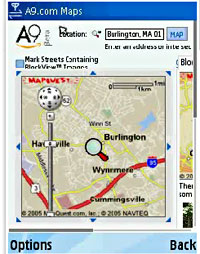 At the W3C conference in Edinburgh today, in a move to get the mobile industry (and possibly more) to standardise on a single Web browser, Nokia has released the source code for the mobile Web browser it developed last year.
At the W3C conference in Edinburgh today, in a move to get the mobile industry (and possibly more) to standardise on a single Web browser, Nokia has released the source code for the mobile Web browser it developed last year.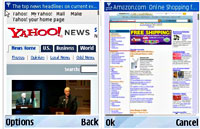 “We want to reduce the fragmentation currently in place in mobile browsing,” said Lee Epting, VP of Forum Nokia, Nokia’s software development support program.
“We want to reduce the fragmentation currently in place in mobile browsing,” said Lee Epting, VP of Forum Nokia, Nokia’s software development support program.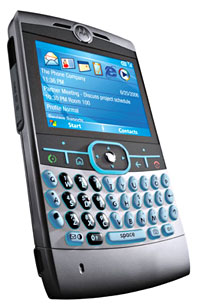 Months later than expected, Motorola’s new ‘Blackberry-killer’ smartphone, the Moto Q has finally been launched on the Verizon network in the US.
Months later than expected, Motorola’s new ‘Blackberry-killer’ smartphone, the Moto Q has finally been launched on the Verizon network in the US.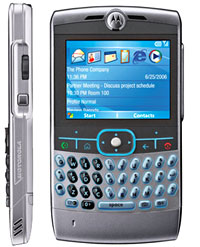 Shockley insisted that the Q is for people with a “life balance” (a what?) who want to use their phones to listen to music, take photos, record short videos and play games.
Shockley insisted that the Q is for people with a “life balance” (a what?) who want to use their phones to listen to music, take photos, record short videos and play games.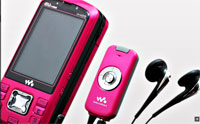 Sony Ericsson has announced its first Walkman phone for Japan today and it looks like a beaut.
Sony Ericsson has announced its first Walkman phone for Japan today and it looks like a beaut.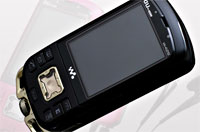 True to its Walkman heritage, the slide-out phone has a smorgasbord of built-in dedicated music controls, including a natty new mechanical navigation wotsit bolted on to the bottom of the phone.
True to its Walkman heritage, the slide-out phone has a smorgasbord of built-in dedicated music controls, including a natty new mechanical navigation wotsit bolted on to the bottom of the phone.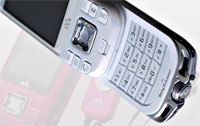 There’s been no firm announcement of the retail price yet, although it’s hotly rumoured to be around the $180 mark, and no announcement of a UK release yet, natch.
There’s been no firm announcement of the retail price yet, although it’s hotly rumoured to be around the $180 mark, and no announcement of a UK release yet, natch.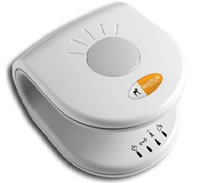 There were a lot of infrastructure companies trying to sell WiFi or WiMAX systems, some in the consumer space, but mainly for service providers. Of the mobile networks, only T-Mobile had a big stand, Orange had a small “business” services stand and O2 had a section of the Cloud’s stand.
There were a lot of infrastructure companies trying to sell WiFi or WiMAX systems, some in the consumer space, but mainly for service providers. Of the mobile networks, only T-Mobile had a big stand, Orange had a small “business” services stand and O2 had a section of the Cloud’s stand.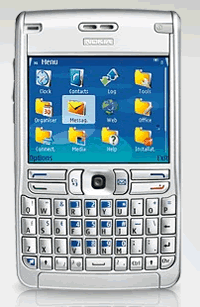 USR aka (US Robotics) have announced a USB handset that works with Skype. It’s really just a USB sound-device, but looks like a phone and has Skype integration (i.e. you can pull your contacts etc from Skype and they show in the phone’s display). They’ve also got a USB Skype conferencing device so several people sitting around a table can listen and speak on the call. Their ADSL/ADSL2+/Wireless routers are all now very simple to configure with wireless security turned on by default and basic ISP settings pre-configured.
USR aka (US Robotics) have announced a USB handset that works with Skype. It’s really just a USB sound-device, but looks like a phone and has Skype integration (i.e. you can pull your contacts etc from Skype and they show in the phone’s display). They’ve also got a USB Skype conferencing device so several people sitting around a table can listen and speak on the call. Their ADSL/ADSL2+/Wireless routers are all now very simple to configure with wireless security turned on by default and basic ISP settings pre-configured. The Cloud were there with a HUGE O2 Exec (aka i-mate JASJAR), anyone using the Exec can log-in to the Cloud’s homepage through WiFi, hit the O2 logo, enter their mobile number and the user will be phoned back. If they enter the digit 1 they’ll be granted access (and billed to that number).
The Cloud were there with a HUGE O2 Exec (aka i-mate JASJAR), anyone using the Exec can log-in to the Cloud’s homepage through WiFi, hit the O2 logo, enter their mobile number and the user will be phoned back. If they enter the digit 1 they’ll be granted access (and billed to that number). Zyxel had a their normal range of wired/wireless and security products. The star of their stand was their keyfob wireless hotspot locator. It works with all modes of WiFi (i.e. 802.11a/b/g) and supports unsecured and secure networks (WEP, WPA etc) showing what networks are available (at least 9 were available around the Zyxel stand).
Zyxel had a their normal range of wired/wireless and security products. The star of their stand was their keyfob wireless hotspot locator. It works with all modes of WiFi (i.e. 802.11a/b/g) and supports unsecured and secure networks (WEP, WPA etc) showing what networks are available (at least 9 were available around the Zyxel stand).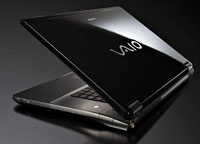 Sony has whipped out its first laptop equipped with a next-generation Blu-ray optical disk drive, saying that it will be available in Japan next month.
Sony has whipped out its first laptop equipped with a next-generation Blu-ray optical disk drive, saying that it will be available in Japan next month.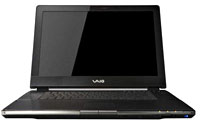 The AR-Series will also come with a HDMI (High Definition Multimedia Interface) output for hooking up the lappie to a HD-ready TV or Full HD desktop display.
The AR-Series will also come with a HDMI (High Definition Multimedia Interface) output for hooking up the lappie to a HD-ready TV or Full HD desktop display.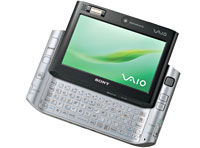 Powered by Intel Core Solo U1400 (1.2 Ghz)/U1300 (1.06 Ghz) the pint-sized PC will sport an Intel 945GMS Express chipset, 512MB RAM, 20/30 GB hard drive and 69 key QWERTY keyboard.
Powered by Intel Core Solo U1400 (1.2 Ghz)/U1300 (1.06 Ghz) the pint-sized PC will sport an Intel 945GMS Express chipset, 512MB RAM, 20/30 GB hard drive and 69 key QWERTY keyboard.